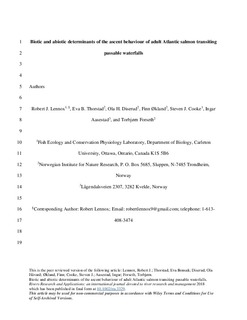Biotic and abiotic determinants of the ascent behaviour of adult Atlantic salmon transiting passable waterfalls
Lennox, Robert J.; Thorstad, Eva Bonsak; Diserud, Ola Håvard; Økland, Finn; Cooke, Steven J.; Aasestad, Ingar; Forseth, Torbjørn
Journal article, Peer reviewed
Accepted version

Åpne
Permanent lenke
http://hdl.handle.net/11250/2572885Utgivelsesdato
2018Metadata
Vis full innførselSamlinger
- Publikasjoner fra CRIStin - NINA [2364]
- Scientific publications [1392]
Originalversjon
10.1002/rra.3329Sammendrag
The spawning migration of Atlantic salmon has been characterized by tracking salmon carrying electronic tags as they ascend rivers, but still little is known about how natural obstacles such as waterfalls influence migratory behaviour and how such behaviours are mediated by various biotic (e.g., fish size) and abiotic (e.g., discharge, water temperature, and barometric pressure) factors. The Norwegian river Numedalslågen is interrupted by natural waterfalls ranging in height from 2 to 6 m. We tagged 113 Atlantic salmon with radio transmitters in the estuary and used stationary radio telemetry stations to track fish. Ninety‐one salmon were recorded in Numedalslågen, 39 of which remained in the river for spawning. Large salmon moved farther and faster upriver but also delayed longer and had lower daily probability to pass the second waterfall. Delay below and passage probability at the final, largest waterfall was affected by water discharge, wherein passage occurred when discharge was declining. Barometric pressure also influenced daily probability of ascent, albeit in opposite directions for each waterfall. Importantly, we also found that salmon with surgically implanted radio transmitters moved farther upriver on average and delayed less time below one of the waterfalls than those with externally attached transmitters. Although there is variance in timing arising from individual decision‐making, we showed that natural waterfalls delay progress of Atlantic salmon on their spawning migration and that both biotic (i.e., size) and abiotic (i.e., barometric pressure and discharge) factors influenced the salmon's decisions to pass waterfalls that they encounter. biotelemetry, exploitation, migration, Salmonidae, straying, waterfall